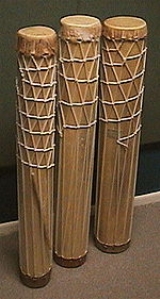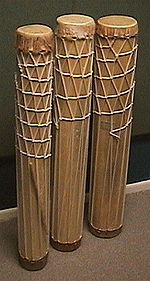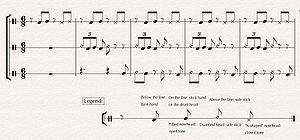
Culoepuya
Encyclopedia
The culo'e puya drums, also known as culoepuya, culo e puya, or culepuya, are a battery of small drum
s originally from Venezuela
, with a Kongo
lineage. They are used in an ensemble also known as redondo drums, after the dance motion and the circle which forms around the dancers during performance.
 The culo'e puya battery comprises three drums made of lightweight wood from the tree known locally as lano or ceiba
The culo'e puya battery comprises three drums made of lightweight wood from the tree known locally as lano or ceiba
de lana (Ceiba pentandra
, a member of the Bombacaceae
family, to which Balsa
also belongs). Both ends have skin heads, which are joined with tensors made of rope (nylon rope is commonly used today). The drums are roughly 1.5m (4 ft.) in length and between 10 and 15cm (4-6 inches) in diameter.
The inside of the drum is carved in the shape of an hourglass, instead of a cylinder.
There are three different diameters, each corresponding to a distinct "voice" or pattern. The different diameters are known as:
 Culo'e Puya drums are typical of the Barlovento region of North-central Venezuela. They are most commonly used in the festivities of the Summer Solstice/St. John the Baptist (June 24) as part of the Redondo ensemble, which also includes one or two maracas, voice and hand claps. The redondo players accompany the processions dedicated to St. John and play alongside it in an ensemble often called tambor pequeño or (small drum), to distinguish it from another battery of drums used during the St. John festivities, known as tambor grande (large drum), or Mina
Culo'e Puya drums are typical of the Barlovento region of North-central Venezuela. They are most commonly used in the festivities of the Summer Solstice/St. John the Baptist (June 24) as part of the Redondo ensemble, which also includes one or two maracas, voice and hand claps. The redondo players accompany the processions dedicated to St. John and play alongside it in an ensemble often called tambor pequeño or (small drum), to distinguish it from another battery of drums used during the St. John festivities, known as tambor grande (large drum), or Mina
.
The basic pattern is usually notated in 6/8 or 12/8
time signatures. Each town in Barlovento has a unique way of interpreting the basic pattern and adds its own local variation, but in general, the prima carries the base of the rhythm and it is played on the upbeats, while the pujao improvises and the cruzao marks the downbeats. This contrasts with the role of the conga drums
in the Cuban rumba
, where the smallest drum is the soloist.
The pujao improvisations are centered around a set pattern, but they can achieve an impressive degree of variety when the percussionist is able to tune the drum while performing. This maneuver is considerably difficult, and it is based on the bass stroke to tune the drum down and a series of side hits to the edge of the drum head with the heel of the bare hand to tune the drum back up.
The Barlovento towns of Curiepe, Tacarigüita, La Boca and Mendoza still maintain the tradition of the Culo'e Puya, but their sound and unique rhythm has influenced the rest of the native forms of Venezuelan music.
Drum
The drum is a member of the percussion group of musical instruments, which is technically classified as the membranophones. Drums consist of at least one membrane, called a drumhead or drum skin, that is stretched over a shell and struck, either directly with the player's hands, or with a...
s originally from Venezuela
Venezuela
Venezuela , officially called the Bolivarian Republic of Venezuela , is a tropical country on the northern coast of South America. It borders Colombia to the west, Guyana to the east, and Brazil to the south...
, with a Kongo
Kongo people
The Bakongo or the Kongo people , also sometimes referred to as Kongolese or Congolese, is a Bantu ethnic group which lives along the Atlantic coast of Africa from Pointe-Noire to Luanda, Angola...
lineage. They are used in an ensemble also known as redondo drums, after the dance motion and the circle which forms around the dancers during performance.
Organology

Ceiba
Ceiba is the name of a genus of many species of large trees found in tropical areas, including Mexico, Central America, South America, The Bahamas, Belize and the Caribbean, West Africa, and Southeast Asia...
de lana (Ceiba pentandra
Kapok
Ceiba pentandra is a tropical tree of the order Malvales and the family Malvaceae , native to Mexico, Central America and the Caribbean, northern South America, and to tropical west Africa...
, a member of the Bombacaceae
Bombacaceae
Bombacaceae is a family of flowering plants or Angiospermae included within Malvales order. As is true for any botanical name, circumscription and status of the taxon has varied with taxonomic point of view...
family, to which Balsa
Balsa
Ochroma pyramidale, commonly known as the balsa tree , is a species of flowering plant in the mallow family, Malvaceae. It is a large, fast-growing tree that can grow up to tall. It is the source of balsa wood, a very lightweight material with many uses...
also belongs). Both ends have skin heads, which are joined with tensors made of rope (nylon rope is commonly used today). The drums are roughly 1.5m (4 ft.) in length and between 10 and 15cm (4-6 inches) in diameter.
The inside of the drum is carved in the shape of an hourglass, instead of a cylinder.
There are three different diameters, each corresponding to a distinct "voice" or pattern. The different diameters are known as:
- Prima - The smallest. Also called hembra (female) or quitimba or quichimba (a word of probable African origin, but whose exact meaning has been lost).
- Cruzao - The middle diameter drum. The name means "hybrid" or "crossed".
- Pujao - The largest diameter. Also called macho (male). The word pujao is a vernacular misspelling of the past participle of the verb pujar, which means to struggle, to push, or (colloquially, in South America) to moan as a result of extreme effort.
Playing technique
Redondo drums are held between the player's legs and played with a stick in one hand and the fingers of the other (bare) hand. There are six basic strokes:- Open stroke with bare hand.
- Closed stroke with bare hand's fingertips.
- Bass stroke with the heel of the bare hand.
- Open stroke with stick on drum head.
- Closed stroke with stick on drum head.
- Side stick.
Rhythms

Mina (drum)
The Mina drum is the largest of the drums that have origins in the Barlovento, Miranda region of Venezuela. They are used during the celebrations of St. John the Baptist and the Midsummer. It is a specialized form of the Cumaco drum...
.
The basic pattern is usually notated in 6/8 or 12/8
Time signature
The time signature is a notational convention used in Western musical notation to specify how many beats are in each measure and which note value constitutes one beat....
time signatures. Each town in Barlovento has a unique way of interpreting the basic pattern and adds its own local variation, but in general, the prima carries the base of the rhythm and it is played on the upbeats, while the pujao improvises and the cruzao marks the downbeats. This contrasts with the role of the conga drums
Conga
The conga, or more properly the tumbadora, is a tall, narrow, single-headed Cuban drum with African antecedents. It is thought to be derived from the Makuta drums or similar drums associated with Afro-Cubans of Central African descent. A person who plays conga is called a conguero...
in the Cuban rumba
Cuban Rumba
In Cuban music, Rumba is a generic term covering a variety of musical rhythms and associated dances. The rumba has its influences in the music brought to Cuba by Africans brought to Cuba as slaves as well as Spanish colonizers...
, where the smallest drum is the soloist.
The pujao improvisations are centered around a set pattern, but they can achieve an impressive degree of variety when the percussionist is able to tune the drum while performing. This maneuver is considerably difficult, and it is based on the bass stroke to tune the drum down and a series of side hits to the edge of the drum head with the heel of the bare hand to tune the drum back up.
The Barlovento towns of Curiepe, Tacarigüita, La Boca and Mendoza still maintain the tradition of the Culo'e Puya, but their sound and unique rhythm has influenced the rest of the native forms of Venezuelan music.
Commercial recordings featuring the culo'e puya
- The American jazz composer Henry ThreadgillHenry ThreadgillHenry Threadgill is an American composer, saxophonist and flautist. Threadgill came to prominence in the 1970s leading ensembles with unusual instrumentation and often incorporating a range of non-jazz genres....
featured two culo'e puya players on his 1993 album Too Much Sugar for a DimeToo Much Sugar for a DimeToo Much Sugar for a Dime is an album by Henry Threadgill, released in 1993 on the Axiom label. It has been described as: "a mad, glorious romp which explores some very dark timbres and tonalities and yet remains witty, fresh and consistently exciting." .-Track listing:# "Little Pocket Size...
. - Cuban pianist Omar SosaOmar SosaOmar Sosa is a composer, bandleader, and jazz pianist.-Biography:Sosa began studying marimba at age eight, then switched to piano at the Escuela Nacional de Musica in Havana, where he studied jazz. Sosa moved to Quito, Ecuador, in 1993, then San Francisco, California, in 1995...
included the sound of culo'e puyas in his release entitled Sentir.
Listening
Video
- Video of a quartet in a studio playing a song accompanied by culo'e puya drums and maraca.
- Another video of Barlovento youths playing and singing with cule'e puya accompaniment.
- Another video of Grupo Mina, a modern Jazz group incorporating culo'e puya rhythms and song in their music.

